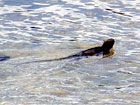

 | |||||||||||||||||||
|
|
Journals 2007/2008Beth Jewell
January 12, 2008 I am staying in the dorm rooms at the Galápagos Research Station and the wildlife here is totally amazing. The animals are not fearful of humans, letting one get very close. Several species of the Galápagos tortoise are kept here. The number of tortoises found on the islands are much lower today than they once were. Tortoises were a source of fresh meat for sailors when whaling was common. They could easily be put on ships and kept alive as they required very little in care. i.e. Darwin Research Station has a breeding program for several species, returning the young to the appropriate island when they reach the age of 5. The breeding program success rate is 97%. The adults are kept in pens as well, although you have to look hard to find the confines of each enclosure. The public is allowed to wander through the pens to get better views of the various tortoises. One enclosure has a special resident- Lonesome George. He is the last of his species and although he has two willing and able females that closely match his DNA, he has shown no interest.
Iguanas are everywhere down by the water. They swim to outcrops of volcanic rocks to eat the algae. As their body chills, they climb out on the rocks to bask in the sun, warming their bodies and restoring their energy. It is mating season and often you will see two males squaring off with another. Not usually much more than some head bobbing and hissing but it can escalate into head banging and blood being drawn. Iguanas have a peculiar way of ridding salt from their bodies- they sneeze it out.
We all gathered for a cruise meeting, mostly for Jon to double check that we were all on the same page and to ask for suggestions. He started by saying that "this is an exciting time to be in the Galápagos doing ecology research." We are at the tail end of a La Niña event and the colder water temperatures are having an effect on the ecology. What they have noticed so far is that coral is bleaching but barnacles are flourishing in many of those spots. People think of El Niño being the harmful phase of the ENSO cycle and La Niña being the good. Jon's research is beginning to suggest that La Niña may harm ecosystems as well. As corals are being bleached, other species such as barnacles are given an opportunity to flourish. This is analogous to forest fires. Although fires clear a forest of trees, they provide an opportunity for new growth. During this cruise we will collect data on the ecology of the Galápagos Marine Reserve, focusing on barnacle and sea urchin food webs along with oceanographic impacts on corals. |
||||||||||||||||||



